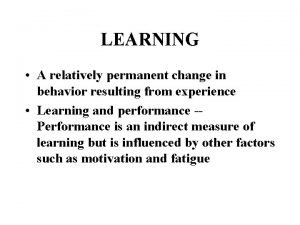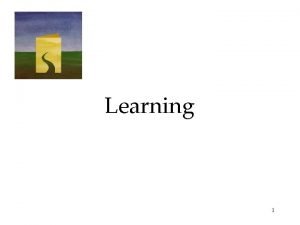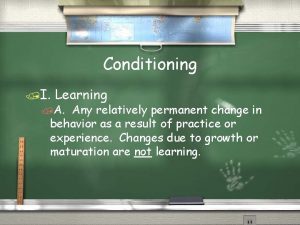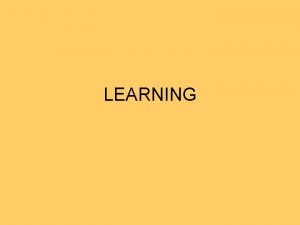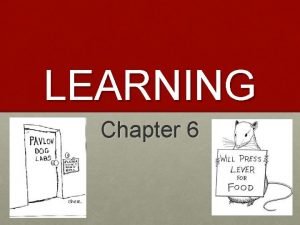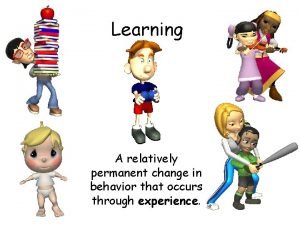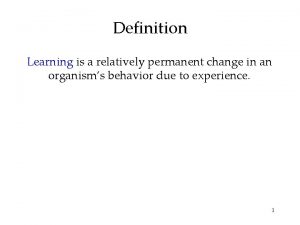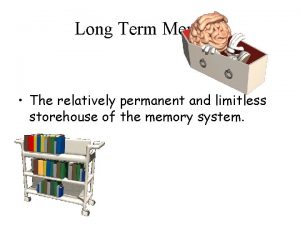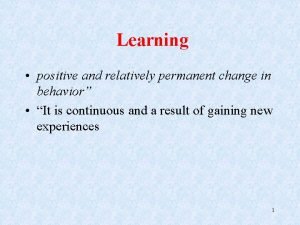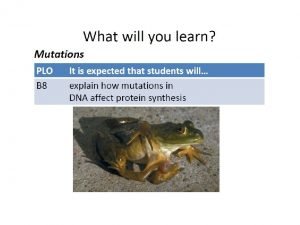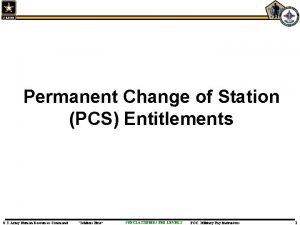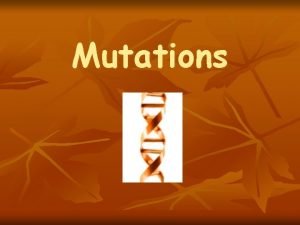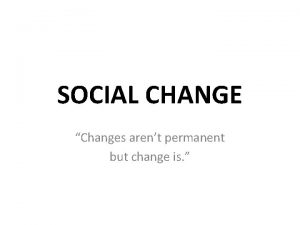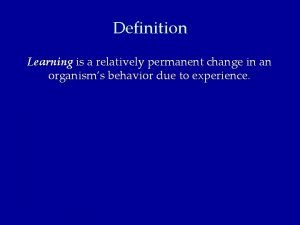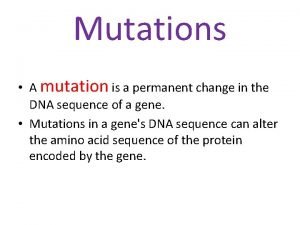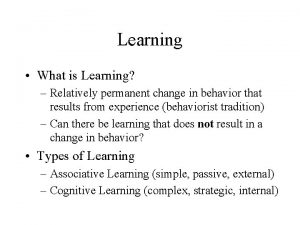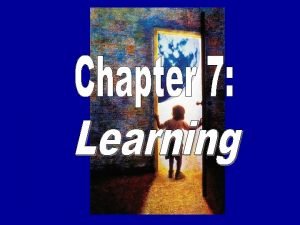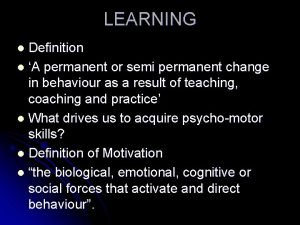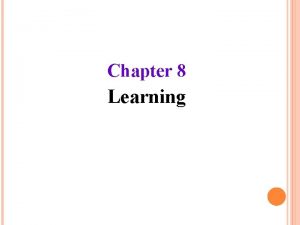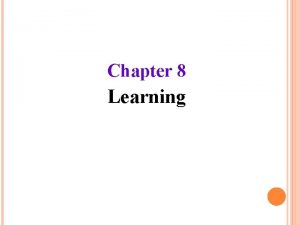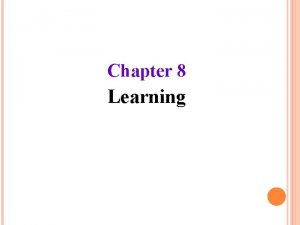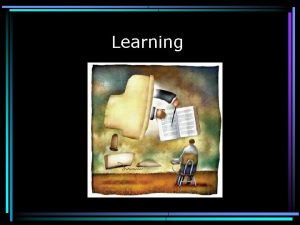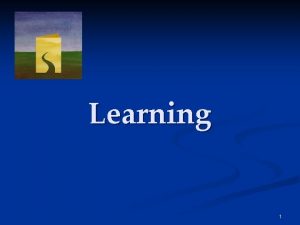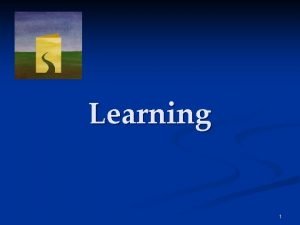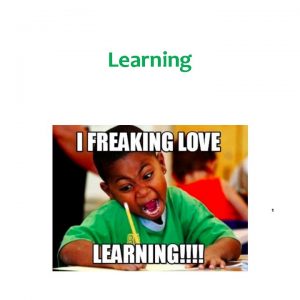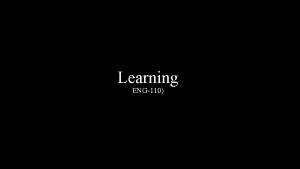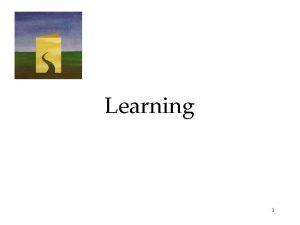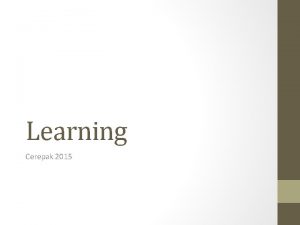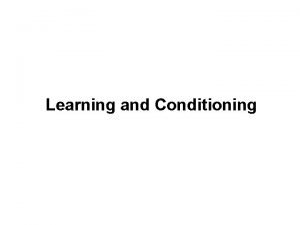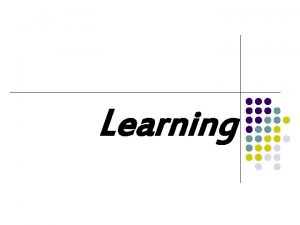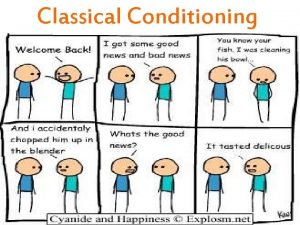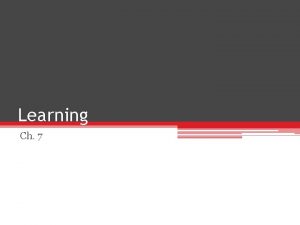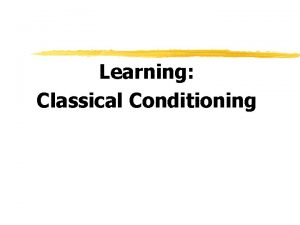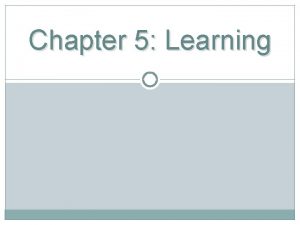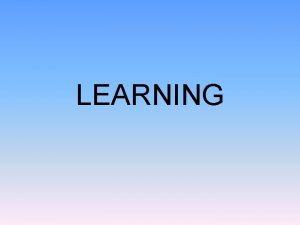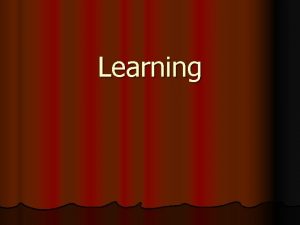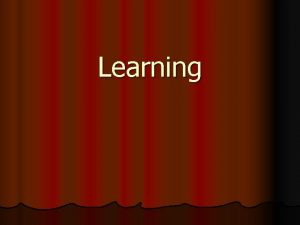Definition Learning is a relatively permanent change in


























- Slides: 26

Definition Learning is a relatively permanent change in an organism’s behavior due to experience. 1

How Do We Learn? We learn by association. Our minds naturally connect events that occur in sequence. 2

Stimulus-Stimulus Learning to associate one stimulus with another. 3

Response-Consequence Learning to associate a response with a consequence. 4

Classical Conditioning Sovfoto Ideas of classical conditioning originate from old philosophical theories. However, it was the Russian physiologist Ivan Pavlov who elucidated classical conditioning. His work provided a basis for later behaviorists like John Watson and B. F. Skinner. Ivan Pavlov (1849 -1936) 5

Classical Conditioning and Pavlov’s Dogs: Hypothesis • Dogs salivate when food is placed in their mouths • Dogs salivate at mere sight of food • Hypothesis: Dogs can be trained, or conditioned, to salivate when exposed to an external stimulus 6

Pavlov’s Methodology and Results • Harness dog and place tube to collect saliva • Present external stimulus (bell) immediately before giving food • Results: After a few trials, the dog salivates upon hearing the bell • Works with other stimuli as well 7

Pavlov’s Conclusions Unconditioned Response Stimulus (UCR) (UCS) because of Conditioned Response (CR) Conditioned Stimulus (CS) because of 8

John Watson and Rosalie Rayner: Hypothesis, Methodology, Results • Conditioned fear into an infant • Presented a rat immediately followed by a loud noise, startling the baby • After a few tries, Albert was afraid of the rat • Albert generalized his fears to other furry objects + = 9

Mary Cover Jones • Colleague of Watson • Deconditioned 3 -year-old Peter from his fears by gradually moving a rabbit (and other things) closer to him while he was eating DAY 1 DAY 2 DAY 3 10

In the video, • What are the US, UR, NS, CR? 11

Continuing Pavlov’s Experiment Other Aspects of Classical Conditioning • • • Acquisition Extinction Spontaneous Recovery Generalization Discrimination 12

Acquisition is the initial stage in classical conditioning in which an association between a neutral stimulus and an unconditioned stimulus takes place. 1. In most cases, for conditioning to occur, the neutral stimulus needs to come before the unconditioned stimulus. 2. The time in between the two stimuli should be about half a second. 13

Acquisition The CS needs to come half a second before the US for acquisition to occur. 14

Extinction When the US (food) does not follow the CS (tone), CR (salivation) begins to decrease and eventually causes extinction. 15

Spontaneous Recovery After a rest period, an extinguished CR (salivation) spontaneously recovers, but if the CS (tone) persists alone, the CR becomes extinct again. 16

Stimulus Generalization Tendency to respond to stimuli similar to the CS is called generalization. Pavlov conditioned the dog’s salivation (CR) by using miniature vibrators (CS) on the thigh. When he subsequently stimulated other parts of the dog’s body, salivation dropped. 17

Stimulus Discrimination is the learned ability to distinguish between a conditioned stimulus and other stimuli that do not signal an unconditioned stimulus. 18

Extending Pavlov’s Understanding Pavlov and Watson considered consciousness, or mind, unfit for the scientific study of psychology. However, they underestimated the importance of cognitive processes and biological constraints. 19

Cognitive Processes Early behaviorists believed that learned behaviors of various animals could be reduced to mindless mechanisms. However, later behaviorists suggested that animals learn the predictability of a stimulus, meaning they learn expectancy or awareness of a stimulus (Rescorla, 1988). 20

Biological Predispositions Pavlov and Watson believed that laws of learning were similar for all animals. Therefore, a pigeon and a person do not differ in their learning. However, behaviorists later suggested that learning is constrained by an animal’s biology. 21

Biological Predispositions Courtesy of John Garcia showed that the duration between the CS and the US may be long (hours), but yet result in conditioning. A biologically adaptive CS (taste) led to conditioning and not to others (light or sound). John Garcia 22

Biological Predispositions Even humans can develop classically to conditioned nausea. 23

Pavlov’s Legacy Pavlov’s greatest contribution to psychology is isolating elementary behaviors from more complex ones through objective scientific procedures. Ivan Pavlov (1849 -1936) 24

Applications of Classical Conditioning Brown Brothers Watson used classical conditioning procedures to develop advertising campaigns for a number of organizations, including Maxwell House, making the “coffee break” an American custom. John B. Watson 25

Applications of Classical Conditioning 1. Alcoholics may be conditioned (aversively) by reversing their positiveassociations with alcohol. 2. Through classical conditioning, a drug (plus its taste) that affects the immune response may cause the taste of the drug to invoke the immune response. 26
 Is a relatively permanent change in behavior
Is a relatively permanent change in behavior Why is learning relatively permanent
Why is learning relatively permanent Relatively permanent change in behavior
Relatively permanent change in behavior A relatively permanent change in behavior
A relatively permanent change in behavior Relatively permanent meaning in psychology
Relatively permanent meaning in psychology Douglas merritte
Douglas merritte A relatively permanent change of behavior is called
A relatively permanent change of behavior is called Spontaneous recovery
Spontaneous recovery The relatively permanent and limitless storehouse
The relatively permanent and limitless storehouse Relatively permanent
Relatively permanent Inversion mutation
Inversion mutation Cuadro comparativo entre e-learning b-learning y m-learning
Cuadro comparativo entre e-learning b-learning y m-learning Dd form 2560 advance pay certification/authorization
Dd form 2560 advance pay certification/authorization What is a beneficial mutation
What is a beneficial mutation Changes aren't permanent but change is
Changes aren't permanent but change is Define permanent change
Define permanent change Permanent change in dna sequence
Permanent change in dna sequence Learning is permanent
Learning is permanent Learning is permanent
Learning is permanent Permanent definition
Permanent definition Painting a wall physical or chemical change
Painting a wall physical or chemical change What is a chemical change
What is a chemical change Absolute change and relative change formula
Absolute change and relative change formula Is an integer subtracted by an integer always an integer
Is an integer subtracted by an integer always an integer Differences between chemical and physical changes
Differences between chemical and physical changes Input and output market
Input and output market Supply and demand curve shifts
Supply and demand curve shifts
